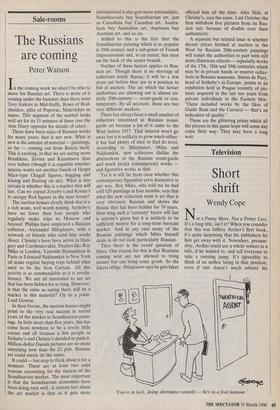Sale-rooms
The Russians are coming
Peter Watson
In the coming week we shan't be able to move for Russian art. There is more of it coming under the hammer than there were Tory traitors in Mid-Staffs. Rows of Rod- chenkos, piles of Popovas, Maleviches en masse. This segment of the market looks well set for its 15 minutes of fame (see the Arts Diary opposite for details of sales).
There have been sales of Russian works for many years: that is not new. What is new is the amount of material — paintings, so far — coming out from Russia itself. This is exciting, in that we are seeing more Brushkins, Zevins and Kazantsevs than ever before (though it is arguable whether anyone wants yet another bunch of Harpo Marx-type Chagall figures, hugging and kissing and floating on air). What is less certain is whether this is a market that will last. Can we expect Zoveby's and Kristie's to occupy Red Square in the near future?
The auction houses clearly think that it is a rich seam, well worth mining. Sotheby's have no fewer than four people who regularly make trips to Moscow and beyond. Phillips have employed a Russian collector, Alexander Shlepianov, with a network of friends who send him works direct. Christie's have been active in Hun- gary and Czechoslovakia. Dealers like Roy Miles in London, Vartouhi Bazmadjian in Paris or Edouard Nakhamkin in New York all make regular buying trips behind what used to be the Iron Curtain. All this activity is as commendable as it is revolu- tionary. We are all interested to see art that has been hidden for so long. However, is that the same as saying there will be a market in this material? Up to a point, Lord Gowrie.
In their favour, the auction houses might point to the very real success in recent years of the market in Scandinavian paint- ings. In little more than five years, this has come from nowhere to be a lovely little earner and all because a few people in Sotheby's and Christie's decided to push it. Million-dollar Danish pictures are no more surprising now than the £2 pint. Russian art could surely do the same.
It could — but stop to think about it for a moment. There are at least two solid reasons accounting for the success of the Scandinavian market. The most important is that the Scandinavian economies have been doing very well. A curious fact about the art market is that as it gets more international it also gets more nationalistic. Scandinavians buy Scandinavian art, just as Canadians buy Canadian art, Austra- lians buy Australian art, Austrians buy Austrian art, and so on.
Added to this is the fact that the Scandinavian painting which is so popular is 19th-century and a sub-genre of French Impressionism and, to an extent, has risen on the back of the senior branch.
Neither of these factors applies to Rus- sian art. Though there is no shortage of collectors inside Russia, it will be a few years yet before they are in a position to bid at auction. The art which the Soviet authorities are allowing out is almost en- tirely 20th-century — avant-garde or con- temporary. By all accounts, these are two very different markets.
There has always been a small number of collectors interested in Russian avant- garde art because a lot of it came to the West before 1917. That interest won't go away but it is unlikely to grow much either: it has had plenty of time to find its level. According to Shlepianov, Miles and Nakhamkin, new collectors dislike the abstractions of the Russian avant-garde and much prefer contemporary works and figurative works at that.
Yet it is still far from clear whether this contemporary figurative art is distinctive in any way. Roy Miles, who told me he had sold 420 paintings in four months, says that what the new collectors want is art that is very obviously Russian and shows the Russia that has been hidden for 70 years. How long such a 'curiosity' factor will last is anyone's guess but it is unlikely to be sufficient motive for a long-term buoyant market. And in any case many of the Russian paintings which Miles himself deals in do not look particularly Russian.
Then there is the vexed question of fakes. One reason for this is that Russians coming west are not allowed to bring money but can bring some goods. So the fakers oblige. Shlepianov says he gets fakes `You're in luck, doing alternative comedy — he's in a foul humour.' offered him all the time. Alex Lich, at Christie's, says the same. Last October the firm withdrew five pictures from its Rus- sian sale because of doubts over their authenticity.
A separate but related issue is whether decent prices fetched at auction in the West by Russian 20th-century paintings will tempt the authorities to part with still more illustrious objects — especially works of the 17th, 18th and 19th centuries which may be in private hands or reserve collec- tions in Russian museums. Simon de Pury, head of Sotheby's in Europe, points to an exhibition held in Prague recently of pic- tures acquired in the last ten years from private individuals in the Eastern bloc. `These included works by the likes of Guido Reni and the Carracci — that's an indication of quality.'
These are the glittering prizes which all the players in this game hope will some day come their way. They may have a long wait.


























































 Previous page
Previous page